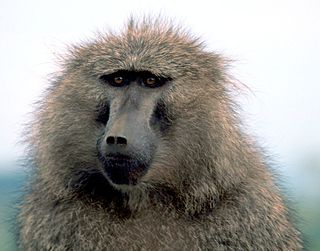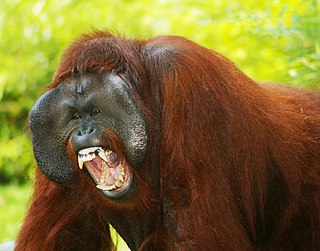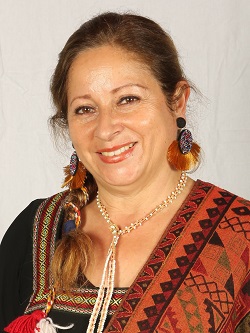
The chimpanzee, also simply known as the chimp, is a species of great ape native to the forests and savannahs of tropical Africa. It has four confirmed subspecies and a fifth proposed one. When its close relative the bonobo was more commonly known as the pygmy chimpanzee, this species was often called the common chimpanzee or the robust chimpanzee. The chimpanzee and the bonobo are the only species in the genus Pan. Evidence from fossils and DNA sequencing shows that Pan is a sister taxon to the human lineage and is thus humans' closest living relative. The chimpanzee is covered in coarse black hair, but has a bare face, fingers, toes, palms of the hands, and soles of the feet. It is larger and more robust than the bonobo, weighing 40–70 kg (88–154 lb) for males and 27–50 kg (60–110 lb) for females and standing 150 cm.

Primates are the members of a diverse order of mammals. They are divided into the strepsirrhines, which include the lemurs, galagos, and lorisids, and the haplorhines, which include the tarsiers and the simians. Primates arose 85–55 million years ago first from small terrestrial mammals, which adapted to living in the trees of tropical forests: many primate characteristics represent adaptations to life in this challenging environment, including large brains, visual acuity, color vision, a shoulder girdle allowing a large degree of movement in the shoulder joint, and dexterous hands. Primates range in size from Madame Berthe's mouse lemur, which weighs 30 g (1 oz), to the eastern gorilla, weighing over 200 kg (440 lb). There are 376–524 species of living primates, depending on which classification is used. New primate species continue to be discovered: over 25 species were described in the 2000s, 36 in the 2010s, and six in the 2020s.

The bonobo, also historically called the pygmy chimpanzee, is an endangered great ape and one of the two species making up the genus Pan. While bonobos are, today, recognized as a distinct species in their own right, they were initially thought to be a subspecies of Pan troglodytes, due to the physical similarities between the two species. Taxonomically, members of the chimpanzee/bonobo subtribe Panina—composed entirely by the genus Pan—are collectively termed panins.

The genus Pan consists of two extant species: the chimpanzee and the bonobo. Taxonomically, these two ape species are collectively termed panins. The two species were formerly collectively called "chimpanzees" or "chimps"; if bonobos were recognized as a separate group at all, they were referred to as "pygmy" or "gracile chimpanzees". Together with humans, gorillas, and orangutans they are part of the family Hominidae. Native to sub-Saharan Africa, chimpanzees and bonobos are currently both found in the Congo jungle, while only the chimpanzee is also found further north in West Africa. Both species are listed as endangered on the IUCN Red List of Threatened Species, and in 2017 the Convention on Migratory Species selected the chimpanzee for special protection.

Primatology is the scientific study of non-human primates. It is a diverse discipline at the boundary between mammalogy and anthropology, and researchers can be found in academic departments of anatomy, anthropology, biology, medicine, psychology, veterinary sciences and zoology, as well as in animal sanctuaries, biomedical research facilities, museums and zoos. Primatologists study both living and extinct primates in their natural habitats and in laboratories by conducting field studies and experiments in order to understand aspects of their evolution and behavior.

Great ape personhood is a movement to extend personhood and some legal protections to the non-human members of the great ape family: bonobos, chimpanzees, gorillas, and orangutans.

Twycross Zoo is a medium to large zoo near Norton Juxta Twycross, Leicestershire. The zoo has the largest collection of monkeys and apes in the Western World, and in 2006 re-launched itself as "Twycross Zoo – The World Primate Centre".

Franciscus Bernardus Maria de Waal was a Dutch-American primatologist and ethologist. He was the Charles Howard Candler Professor of Primate Behavior in the Department of Psychology at Emory University in Atlanta, Georgia, director of the Living Links Center at the Yerkes National Primate Research Center at Emory, and author of numerous books including Chimpanzee Politics (1982) and Our Inner Ape (2005). His research centered on primate social behavior, including conflict resolution, cooperation, inequity aversion, and food-sharing. He was a member of the United States National Academy of Sciences and the Royal Netherlands Academy of Arts and Sciences.

Kanzi, also known by the lexigram , is a male bonobo who has been the subject of several studies on great ape language. According to Sue Savage-Rumbaugh, a primatologist who has studied the bonobo throughout his life, Kanzi has exhibited advanced linguistic aptitude.

Research into great ape language has involved teaching chimpanzees, bonobos, gorillas and orangutans to communicate with humans and each other using sign language, physical tokens, lexigrams, and imitative human speech. Some primatologists argue that the use of these communication methods indicate primate "language" ability, though this depends on one's definition of language. The cognitive tradeoff hypothesis suggests that human language skills evolved at the expense of the short-term and working memory capabilities observed in other hominids.

Emily Sue Savage-Rumbaugh is a psychologist and primatologist most known for her work with two bonobos, Kanzi and Panbanisha, investigating their linguistic and cognitive abilities using lexigrams and computer-based keyboards. Originally based at Georgia State University's Language Research Center in Atlanta, Georgia, she worked at the Iowa Primate Learning Sanctuary in Des Moines, Iowa from 2006 until her departure in November 2013. She currently sits on the Board of Directors of Bonobo Hope.
Frances J. White is a British biological anthropologist, professor, and primatologist at the University of Oregon. As a behavioral ecologist, her research focuses on the evolution of primate sociality and social systems. She has studied the socioecology of the bonobo chimpanzee for over 35 years at Lomako Forest in the Democratic Republic of Congo. She is the foremost American authority on this species in the wild and has done extensive field research on the bonobo or pygmy chimpanzees. Her bonobo research examines why bonobos have evolved a very different social system compared to the closely related chimpanzee.

Animal non-reproductive sexual behavior encompasses sexual activities that non-human animals participate in which do not lead to the reproduction of the species. Although procreation continues to be the primary explanation for sexual behavior in animals, recent observations on animal behavior have given alternative reasons for the engagement in sexual activities by animals. Animals have been observed to engage in sex for social interaction bonding, exchange for significant materials, affection, mentorship pairings, sexual enjoyment, or as demonstration of social rank. Observed non-procreative sexual activities include non-copulatory mounting, oral sex, genital stimulation, anal stimulation, interspecies mating, and acts of affection, although it is doubted that they have done this since the beginning of their existence. There have also been observations of sex with cub participants, same-sex sexual interaction, as well as sex with dead animals.
Magdalena (Magda) Bermejo is a Spanish primatologist and world authority on the western lowland gorilla. Since 1991 she has lived for long periods with her husband, German Illera, in the rainforests of the Republic of Congo, conducting research and becoming increasingly involved in gorilla conservation. She estimated that 5,000 gorillas died from Ebola in Gabon and the Republic of Congo.

Centro de Estudios Públicos (CEP) is a non-profit Chilean think tank founded in 1980. Its stated mission is to “contribute to the development of a free and democratic society” through: 1) the analysis and dissemination of philosophical, political, social and economic problems of interest to Chilean society; 2) the study, discussion and design of public policies; and 3) the promotion of institutions that support and enable the existence of a constitutional and democratic order. CEP contributes to the public debate through its seminars, the policy brief Puntos de Referencia, the journal, Estudios Públicos which has appeared continuously since 1980, the publication of books and various research studies, as well as social surveys, which have been conducted since 1987. CEP has become a household name for political, academic, and intellectual debate.
Amy Parish is a Biological Anthropologist, Primatologist, and Darwinian Feminist. She has taught at the University of Southern California in the Gender Studies and Anthropology departments since 1999. She is recognised as being a world leading expert in bonobo studies.
The Puerto Hurraco massacre was a mass murder that occurred on the afternoon of Sunday, 26 August 1990 in Puerto Hurraco, a village in Benquerencia de la Serena, municipality in the Province of Badajoz,. It has 135 inhabitants. The perpetrators were the brothers Emilio and Antonio Izquierdo, members of the "Izquierdo family", who murdered 9 people in the streets of their hometown, some of them belonged to their rivals, the "Cabanillas family", and caused serious injuries to 12 others. The two then fled, but they were arrested during the next morning and eventually sentenced each to 684 years in prison. They died in prison, aged 72 and 74.
Panpanzee the chimpanzee, was born at the Language Research Center at Georgia State University in Atlanta, Georgia. She lived the rest of her life at the Great Ape Trust in Iowa. Her half-brother is Kanzi, a famous bonobo. Kanzi learned 348 lexigram symbols and over 3,000 words from the English language over her lifespan.

Eduardo della Maggiora is a Chilean triathlete and businessman.

Isabel Selena Godoy Monárdez is a Qulla activist and politician in Chile. A former political prisoner during the Chilean military dictatorship, Godoy was elected in 2021 to represent the Qulla people at the Constitutional Convention.
















